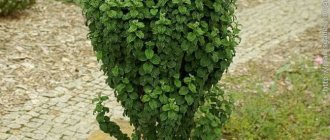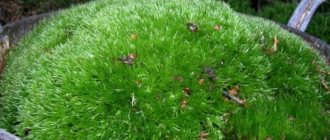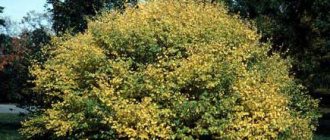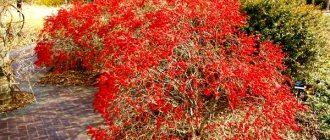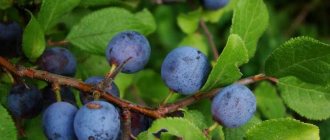- October 20, 2018
- Trees and shrubs
- Julia Master
The almond bush is rightfully considered by gardeners to be one of the most beautiful ornamental shrubs. Its abundant flowering occurs in April-May, during this period it is the main decoration of the garden. There are many varieties of almonds, differing in flower color and flowering period.
Botanical description
Almond (lat. Amygdalus) is an ornamental shrub or tree from 1 to 6 m high, belongs to the Rosaceae family and is a relative of fruit trees (apricot, plum, cherry, etc.). It belongs to the stone fruit crops, although it has fruits in the form of nuts. Ordinary almonds are divided into 2 types: bitter and sweet. The fruits of its wild species are not eaten due to the content of hydrocyanic acid in the kernels - this species is grown for the production of medicines.
For many centuries, this beautifully flowering and fertile plant grew in the Mediterranean and Central Asia. Now almond planting has spread to several continents, from Europe, China to the USA. In the wild, almonds grow in groups at an altitude of up to 1.6 km. In Russia, the almond bush has become widespread in the southern regions.
Fruits and their uses
The plant is valuable not only for its decorative qualities, but also for its tasty and healthy fruits - almonds. The fruits usually ripen in summer (June-July); in appearance they look like pubescent drupes covered with gray-green hair. Inside the thin shell is a seed (nut) up to 2 cm in size, having a rounded shape on one side and a sharp tip on the other.
Almond nuts are widely used in cosmetology and medicine; they are used in therapeutic diets and for weight loss. In cooking, the fruits are very popular for making cakes, pastries and other desserts. Almonds are used in the production of alcoholic beverages.
Harvest and storage
During the period of ripening of the fruits of the almond bush, the shell begins to crack at the edges, making it much easier to separate it from the fruit. Inside the shell there is an oval-oblong stone of a brownish hue, up to 3 cm long. The finished harvest can be harvested at the end of July . The seed, separated from the pericarp, is dried in open sunlight or in the oven. A fabric bag or cardboard box is suitable as a storage container. The fruits should be kept in a dry and well-ventilated area.
Important! Almonds respond well to pruning and grow rapidly, so errors during the removal of branches can be corrected next season.
Selecting a site for planting
Before planting an almond plant on your site (photo below), you should choose a suitable place for it. In order for the plant to be healthy and bloom abundantly, it needs a space protected from wind and drafts, and a large amount of sun. Almonds do not tolerate shade, so the southern part of the site, which is well lit all day, will be optimal.
The shrub does not have any special requirements for the soil, but prefers sandy loam or light loamy soils that have a good supply of nutrition (preferably fertilized with compost). Groundwater should not come close to its roots: if an area on clay soil is flooded, the plant will die. The soil must be non-acidic, pH = 4.5-7.5, otherwise it is better to neutralize it by adding lime.
Almond tree - growing conditions
Growing a tree with almond nuts on your own plot is not difficult at all:
- We choose a seedling . It is better not to take risks and plant varieties and hybrids that are zoned for cultivation in a given area. An indigenous inhabitant of hot eastern countries, almonds easily tolerate winter frosts down to -35°C, but at the same time suffer from spring frosts, which have a detrimental effect on the future ovary. In areas with harsh winters and prolonged spring weather, almond trees are grown as ornamental plants.
- We determine the area . Almond trees have adapted to survive in arid regions with very hot climates. This made them not demanding on the quality of the soil: both rich black soil areas and poor rocky or sandy ones are suitable. The only thing they cannot tolerate is stagnation of groundwater and acidic soil reaction. The best option for planting an almond tree seedling would be a well-lit area protected from strong winds with light soil rich in nutrients.
- We select a company for the seedling . In order for an almond tree to bear fruit, it must be pollinated. Depending on the variety, two options are possible: cross-pollination (you will have to plant several more related seedlings at a short distance from each other) or insect pollination (several hives with bees should be placed nearby).
Reproduction
Ornamental almond shrubs can be propagated in several ways:
- Division, in which a very overgrown bush can be divided into several parts, which are planted separately.
- Root shoots, which often grow after the next pruning of branches, are planted in the second year after the formation of a good root system.
- Cuttings are carried out after preliminary preparation: cuttings are cut out in July, selecting parts with 2-3 nodes; when planting, they are buried, leaving only one on top of the soil; During the first wintering, the plantings must be insulated with straw or leaves.
- Layering - done by bending shoots to the ground, which are sprinkled with earth; after the roots appear (after 1 year), the layering can be separated and planted.
- Propagation by seeds is carried out in the fall, immediately after collecting almonds from the bush, planted to a depth of 8 cm, and also in the spring - to a depth of 6 cm, making preliminary stratification.
- Almonds can be grafted onto sloe, cherry plum or plum bushes, after which budding is done in mid-summer.
Variety of varieties
Common almonds have many varieties, some of them grow as trees (up to 6 m in height), others as shrubs.
Almond plants planted in central Russia have good resistance to frost, however, due to early flowering, many buds may freeze, which affects the size of the crop. To get guaranteed good fruits, experts recommend planting varieties that have a long period of bud formation and later flowering.
The most suitable frost-resistant varieties:
- “Nikitsky” is a shrub up to 5 m high, has large fruits and a long dormant period, good yield, suitable for growing in any region of Russia, blooms in mid-April, but for pollination it is necessary to plant a plant near it with the same flowering period.
- “Primorsky” - height up to 3.5 m, blooms in April, fruits are elongated with a rounded base and a sharp tip, a large harvest ripens by mid-November.
- “Dessert” - has a dense spherical crown, height up to 4.5 m, flowering in April, the fruits are oval in shape with a slightly pointed tip.
Shrub varieties
Lower varieties of shrubs:
- “Petiolate” - has high productivity and winter hardiness, a shrub up to 2.5 m high, late flowering, a large number of fruits, but the size is slightly smaller than other varieties.
- Common almonds are the most popular among gardeners.
- “Three-lobed” is a spreading bush up to 3 m high, with flowers arranged in pairs on the branches, the leaves form 3 lobes and are covered with pile at the bottom, has 2 decorative subspecies (“plena” and “Kyiv”).
- “Steppe” is a deciduous shrub (also called “low” or “bean”) up to 1.5 m high with a spherical crown, distinguished by bright pink buds, oblong lanceolate leaves, short flowering (10 days), inedible fruits.
- “White Sail” is an almond bush (photo below) of a southern variety, decorated with snow-white buds, flowers up to 1 cm in size, characterized by increased drought resistance, and can go without watering for a long time.
- “Plena” - has pinkish flowers that bloom immediately after the first leaves appear.
- “Kyiv” - decorated with fluffy flowers of a rich pink hue, which bloom even before the leaves appear.
- “Anyuta”, “pink mist” - bushes with pink flowers of several shades.
- “Pink Flamingo” is an early variety, blooms earlier than others, is decorated with double pink flowers, and is often used in landscape design to decorate personal plots.
- Georgian almond, growing only on the slopes of the Caucasus, is a bush up to 1 m high, frost-resistant, has large flowers of deep pink color and long leaves (up to 8 cm), blooms in May, frost-resistant, drought-resistant variety - used in breeding work, resistant to pests and diseases, life expectancy is up to 30 years.
- “Ledebura” - a light-loving, frost-resistant variety, common in Altai - is distinguished by bright pink-red flowers that bloom earlier than other varieties, the duration of abundant flowering is 3 weeks, fruiting begins at the age of 10.
- “Petunnikova” is a shrub species common in Central Asia, up to 1 m high, the crown is in the shape of a ball, the bark on the branches has a gray-brown tint and a yellow tint, the leaves are lanceolate, have jagged edges, it begins to bloom at 3 years in May, the flowers are pink, fruiting begins at 5 years of age, the nuts are yellow-orange and small.
- Hybrid variety (No. 3) - its flowering resembles Japanese sakura, the flowers are double, bright pink.
Almond bush: planting and care, photo
The plant is planted in open ground in 2 terms:
- in spring, after the onset of warm weather;
- in autumn (middle and end), after the leaves fall from the trees.
Shrub planting procedure:
- Dig a hole in the chosen place up to 30 cm deep, the interval between bushes should be at least 3 m.
- Fill the drainage (broken bricks, crushed stone), and sand on top.
- A support in the form of a pole is placed in the center, rising 50 cm above the ground.
- Place the plant in the hole so that the root collar is 3-4 cm higher.
- Fill the hole with prepared soil mixture (sand, humus, leaf soil).
- Pour a bucket of water and mulch with peat.
Almond tree - planting
Once the variety has been determined and the optimal location for growing almonds has been selected, planting work can begin. It is better to plan them for the fall, since spring planting often leads to the death of the seedling or a significant slowdown in its development. Let's look at how to plant an almond tree step by step:
- We dig a planting hole of approximately 60x60 cm for each seedling. Maintain a distance between seedlings of at least 4 m.
- At the bottom of the pit we lay a thick layer of drainage (brick fragments, crushed stone, gravel), which is necessary to drain water.
- Fill the hole halfway with soil-sand-turf mixture (ratio 1:2:3) with the addition of humus (5.5 kg) and superphosphate (0.5 kg). If necessary, reduce the acidity by adding dolomite flour or lime.
- We install a support in the hole, with which we then tie up an almond tree seedling.
- We cover the roots of the seedling with a clay mash, and then carefully straighten it inside the hole. In this case, the root collar should remain above the soil level.
- Carefully fill the hole with earth.
- We mulch the soil around the almond tree with peat, first watering it abundantly (at least 12 liters).
Watering and caring for shrubs
Decorative almonds (photo above) have many advantages, including fast growth, unpretentiousness, good adaptation to urban conditions, they are not afraid of drought and are a valuable honey crop.
The list of care activities includes:
- regular watering (no more than once a week), because the plant does not like stagnant water;
- mandatory loosening of the soil after watering (to a depth of 7 cm);
- removing weeds around the plant;
- feeding in spring (mullein or manure), in autumn (superphosphate or potassium);
- ensuring safe wintering - covering seedlings with straw, leaves, etc., layer height of at least 15 cm, adult bushes can be covered.
Almond tree care
The first years after planting, caring for an almond tree consists of regularly removing weeds from the tree trunk, loosening the soil in it and abundant watering. When irrigating, it is important to maintain the “golden mean”, giving the plant the required amount of liquid and avoiding stagnation with subsequent rotting of the trunk and roots. During this period, the seedling devotes all its efforts to strengthening the underground (root) part, so it hardly changes in appearance.
When the rooting process is completed, the phase of active growth of the above-ground part begins. The almond tree is rapidly increasing in growth and volume, producing more and more new shoots. Mandatory care includes regular application of fertilizers (a lot of them are needed, because a fast-growing tree spends a lot of energy and depletes the soil) and shaping pruning (without it, the crown thickens very quickly). If circumstances are favorable, already 5 years after planting you can enjoy the first harvest of delicious and very healthy almond nuts.
How to feed an almond tree in spring?
In spring, almonds need nitrogen more than ever. This microelement is necessary for the growth of shoots and the formation of buds. Fertilizing an almond tree with nitrogen is done in late April-early May by dissolving 25 g of ammonium nitrate in water and applying it to the tree trunk. Ammonia fertilizing can be combined with copper-containing fertilizer. To enrich the soil, saturating it not only with nitrogen, but also with oxygen, and also to attract pollinating insects to the almond trees, it is recommended to plant green manure (alfalfa, peas, mustard, lupine and other crops) between them.
How to form an almond tree?
For the crop to fully ripen, sunlight is necessary, so it is important to understand how to properly prune an almond tree:
- Almonds are pruned twice a year, at the beginning and end of the growing season. This allows you to save the strength of the tree and avoid thickening the crown.
- After planting, the seedlings are pruned at a height of 1.2 m, forming a standard of 80 cm and a crown of 40 cm. On the standard, all shoots are cut into a ring, and in the crown area they are shortened by 2-3 eyes. The strongest 3-4 shoots are left; they will later become skeletal branches. This is how a bowl-shaped crown is formed over several years.
- Pruning mature trees involves removing crooked, damaged and broken shoots.
- Old and unpruned almond trees can be rejuvenated by radical pruning.
How to propagate an almond tree?
In nature, almond propagation occurs by seeds; in culture, vegetative methods are more often used: root shoots and cuttings. Standard decorative almonds can be propagated by budding using a plum as a rootstock. Let's take a closer look at how to grow an almond tree from a cutting:
- Propagation material is prepared in July by cutting strong cuttings at least 15 cm long, with two nodes, lignified, but not yet lost their flexibility.
- The cuttings are rooted in the schoolhouse, where they will overwinter. The soil there should be nutritious and loose (a mixture of fertile soil and peat). For the winter, the schoolchild must be protected from frost with lutrasil, straw or fallen leaves.
Source
Trimming
In order for the decorative almond bush (photo below) to have an aesthetic appearance and beautiful flowering, it needs to be regularly pruned in several stages:
- spring – sanitary pruning (removal of diseased and damaged branches);
- the formation of the crown (usually in the shape of a bowl) is done after the almonds bloom - the branches are cut using the thinning method so that a ring is formed;
- at the end of August it is necessary to cut off the apical buds so that they do not freeze in the winter months;
- in the eighth year of life, the removal of old branches is mandatory.
After pruning, the cut areas should be lubricated with a fungicide or garden varnish.
Almonds in landscape design
Many experienced gardeners choose almonds as a decorative decoration for their home garden because of its unusually beautiful flowering . The shrub is often planted on lawn grass, slopes or next to garden stones. The shape of the crown, thought out in advance, can shade resting areas or, if a large number of bushes are planted, form a beautiful walking alley.
Bush formation
The crown of a mature ornamental bush is pruned like a peach tree in several stages every year:
- At the beginning of spring, the first sanitary pruning takes place.
- After vigorous flowering, branches that are characterized by too active growth are removed. This helps the trunks ripen and direct their forces to the formation of young shoots.
- Then they often give the desired shape: they create a trunk up to 55–70 cm in height, and leave 5–7 branches on the main trunk.
- In the summer season, all shoots that extend beyond the edges of the form are pinched. Planned pruning of branches that have grown over 60 cm is also carried out.
Did you know? Bitter almonds contain a large amount of poison called amygdalin glycoside, which gives the product a specific taste.
That is why the fruits of the bush cannot be eaten without special treatment (the lethal dose of bitter nuts
is
50 pieces).
Tree formation
Creating a crown consists of the following steps:
- You need to decide on the height of the trunk: choose the one from which young branches should begin to grow. All other lower shoots must be cut to zero.
- Next you need to select a skeletal branch. Its role will be played by the maximum height escape from the bottom row. It should be very strong and fully formed.
- The nearest branch, which is located at a height of 15 - 20 cm from the main skeletal one and looks in the opposite direction from it, will become the second skeletal one.
- The third skeletal branch should be 15 - 20 cm above the second and look perpendicular to the above shoots.
- Without exception, all branches that grow in the area of the three skeletal ones are cut to zero.
- Controlling the main trunk will help regulate the tree's upward growth. It should be 0.5 m higher than the last branch.
After pruning, you need to monitor the growth of young shoots . They should not thicken the crown and dominate the skeletal branches. Excess shoots that stray from the overall shape of the bush are corrected by pruning. When cutting dense branches, you need to blot the cut areas with a garden decoction to heal cuts and wounds (a mash of 200 g of clay, 100 g of manure and 100 g of lime, diluted with water to a state resembling thick sour cream, is suitable). This will stimulate rapid recovery of the tree.
Also learn about varietal almond trees.
Almonds on a trunk
The standard almond tree looks as impressive as a bush-shaped garden plant. A seedling of the desired shape can be purchased ready-made from specialized specialists or created yourself . Moreover, it is quite simple to do this. The easiest method of forming a trunk is to trim the crown, which will help create a trunk. The procedure takes a lot of time, but is very effective.
The formation of a trunk can be accomplished by tying a straight seedling (necessarily without knots) to a standing wooden support immediately after transplanting to the prepared area. After the bush has entered the stage of active growth, the top must be tied to a hammered peg, and all side branches must be cut off. This will give the bush a hat shape.
Bright and distinctive decorative almonds are resistant to extreme heat and cold winters. With proper care, it will delight the eye with spectacular flowering for a long time: the crop can grow on the site for up to 100 years. Thanks to the variety of options for crown formation, you can easily complement the landscape design of your garden with an original and unpretentious plant.
Diseases and pests
The almond bush is susceptible to various diseases that need to be treated:
- gray rot - diseased branches need to be cut off after the bush has flowered;
- leaf curl - treat with Bordeaux mixture, first removing all damaged leaves;
- moniliosis (a fungal disease that affects young weakened shoots) - treatment is carried out in the same way, spraying should be repeated every 15-20 days, for prevention, pruning should be carried out annually after flowering;
- rust - treated by treating branches with a colloidal aqueous suspension of sulfur or powder.
The shrub is susceptible to attack by pests, including aphids, plum moths, and leaf rollers. To kill insects, it is recommended to spray with a prepared solution of chlorophos or karbofos.
Decorative properties
The almond bush (photo below) usually begins to bloom only when the plant reaches four years of age. This is incredibly beautiful - the bush is covered with double white or pink flowers of various shades, which not only decorate the garden plot, but also fill it with a wonderful aroma. Its delicate flowers attract honey plants, which flock from all over the area.
In landscape design, almonds are used in low varieties, which are ideal for decorating open spaces and rockeries. It is also planted in the background in mixborders, where it attracts attention in the spring months. In summer it becomes an excellent backdrop for planted perennial flowers.
What does a blooming almond look like?
The lush almond blossom is such a mesmerizing sight that it cannot leave anyone indifferent.
Did you know? World Almond Day, which falls on February 16, is celebrated primarily in the United States, which accounts for 65% of global almond production. Almond Blossom Days are celebrated in Spain and Portugal.
The white-pink cloud that envelops branches that have not yet covered with leaves in early spring against the backdrop of a bright blue spring sky has not escaped the attention of many generations of Eastern poets. In many countries with mild climates, the flowering of almond plants is associated with the beginning of spring.
The flowering branches of this plant have forever entered the world treasury of painting thanks to the famous painting by Van Gogh, which is called “Blossoming Almond Branches.”
Even the ancient Egyptians, the beauty of the blooming almond plant forced them to include almond branches with flowers in magical rituals, the ancient Chinese associated the blooming almond with female beauty, the ancient Romans considered it a symbol of fertility, and the Persians called it the Tree of Heaven.
Did you know? Archaeological research indicates that the almond plant was familiar to people in ancient times. This plant is even mentioned in the Bible.


